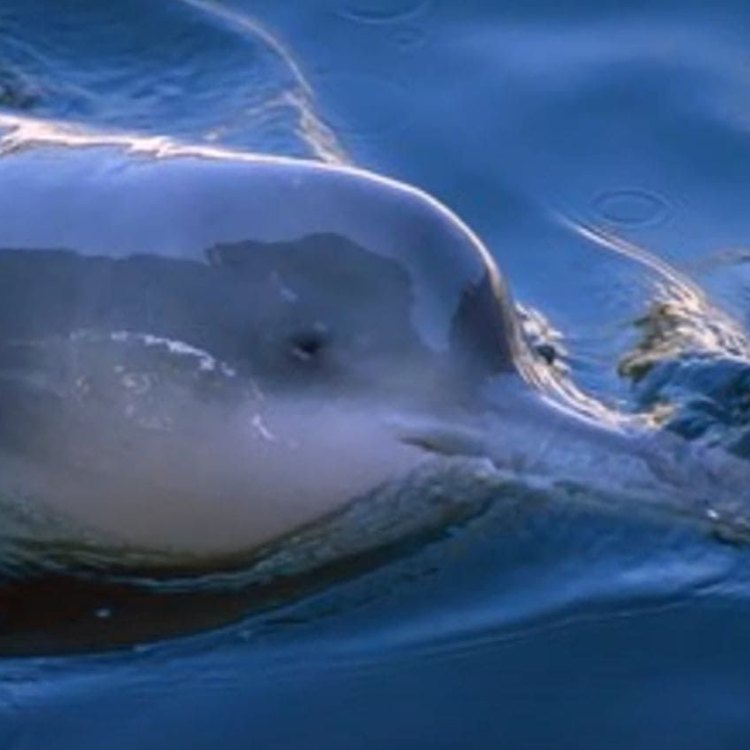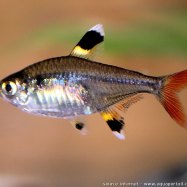
Baiji
2.3 - 2.7 meters (7.5 - 8.9 feet)
The Baiji, also known as the Yangtze River dolphin, is a unique and endangered species of freshwater dolphin. It can reach lengths of 2.3 to 2.7 meters and is found in the Yangtze River in China. With its cylindrical and elongated body, this member of the Lipotidae family is truly one-of-a-kind. Help protect this special animal by learning about its habitat and conservation efforts. #Baiji #YangtzeRiverDolphin #EndangeredSpecies #FreshwaterDolphin
Animal Details Summary:
Common Name: Baiji
Kingdom: Animalia
Habitat: Freshwater
The Tragic Tale of the Baiji: A Unique and Endangered River Dolphin
The world of aquatic life is a vast and beautiful one, filled with animals of all shapes and sizes. From the mighty blue whale to the tiny sea otter, our oceans and rivers are home to a diverse range of creatures. However, among these creatures lies one unique and enigmatic animal that remains shrouded in mystery – the Baiji.Scientifically known as Lipotes vexillifer, the Baiji is also referred to as the Chinese river dolphin or Yangtze river dolphin Baiji. It belongs to the Kingdom Animalia, Phylum Chordata, and Class Mammalia, and is the only species within the family Lipotidae. Found primarily in the Yangtze River in China, the Baiji is a freshwater mammal that has captured the hearts of many but is now on the brink of extinction.
This article will take you through the fascinating features of the Baiji, its current status, and the steps being taken to save this critically endangered species.
Finding the Baiji in its Natural Habitat
The Baiji is an elusive and mysterious creature that is only found in the Yangtze River. This river, known as the 'Golden Dragon' to the Chinese, is the longest river in Asia and the third-largest in the world. The Baiji calls this river its home, dwelling in the murky waters that flow through the heart of China.This elusive creature prefers to live in deep pools of the river, where it can be found swimming alone or in small groups of two to three. It tends to avoid areas of high boat traffic and can often be found hiding in the muddy riverbed. With its cylindrical and elongated body shape, the Baiji is perfectly adapted to moving efficiently through the water, using its large flippers to maintain balance and propel itself forward Blue Dragon Sea Slug.
A Unique Appearance
One of the most intriguing features of the Baiji is its unusual appearance. It has a light gray or bluish-gray body with a pale underbelly, making it almost blend in with the murky waters of the Yangtze River. Its dorsal fin is triangular and stands tall as it cuts through the water surface when the Baiji comes up for air.The Baiji also has a long and narrow beak, similar to that of a bottlenose dolphin, but with a slight curve at the end. This beak is used to help the creature navigate through the water and catch its prey.
Feeding and Hunting Habits
Unsurprisingly, the Baiji is a carnivorous animal and feeds on a variety of freshwater fish such as carp, perch, and catfish. It uses echolocation, a process of producing and sensing sound waves to locate and hunt its prey. Once it has located its target, the Baiji will use its beak to stun the fish before consuming it.Experts have found that the Baiji feeds mainly during the night, using its sensitive nose to detect vibrations of fish movement in the water. This feeding behavior is a result of the high levels of boat traffic found during the day, making it difficult for the Baiji to hunt efficiently.
An Endangered Species
The Baiji has a long and tragic history of decline, with humans being the main cause of its dwindling population. As far back as the 1950s, industrialization and pollution of the Yangtze River began, affecting the Baiji's habitat and food sources. Over the decades, human activities such as overfishing, boat traffic, and construction of dams have continued to harm the Baiji's habitat, leading to a sharp decline in its population.According to the Baiji Foundation, the population of Baiji in the Yangtze River has decreased by 96% over the past four decades, with only a few remaining in the wild. In 2006, a comprehensive survey was conducted, and it was confirmed that the Baiji was functionally extinct, with no sightings of the animal for over two years. This was a devastating blow, and sadly, the Baiji has not been seen in its natural habitat since.
A Desperate Fight for Survival
Though the Baiji has not been sighted in the wild for over a decade, conservation efforts are still ongoing to save this unique and endangered species. The Chinese government has taken steps towards protecting the Baiji, including imposing a fishing ban in its habitat and establishing a conservation program. These efforts have led to the establishment of conservation areas and the release of captive Baijis into the wild.Other organizations, such as the Baiji Foundation, are also working tirelessly to raise awareness about the plight of this aquatic mammal and help in its conservation efforts. The foundation's efforts include advocating for stricter regulations on boat traffic and conducting research to understand the Baiji's behavior and how to better protect it.
The Lingering Mystery of the Baiji
Despite all efforts, the Baiji remains a mystery. It is believed that a few Baijis may still exist in the Yangtze River, but without sightings, it is impossible to say for sure. Experts also believe that it may have lost its reproductive ability due to years of pollution, making it impossible to increase its population.Some scientists are hopeful that Baijis may still exist in the wild, perhaps in some hidden pockets of the Yangtze River. However, with the completion of the Three Gorges Dam, which has altered the river's flow and caused significant damage to the Baiji's habitat, the chances of finding it are slim.
In Conclusion
The Baiji is an incredibly unique and critically endangered animal that has captured the hearts of many. Its tragic decline is a clear indication of the damaging effects of human activities on the environment and the urgent need for conservation efforts. Without immediate and drastic action, the Baiji may disappear from our planet forever, leaving us with only photographs and memories of its elusive existence.We must continue to raise awareness about the Baiji and support conservation efforts to save this incredible species. By taking a stand and working together, we can make a difference in saving the Baiji and preserving the biodiversity of our planet. It is up to us to ensure that the Baiji, and all other endangered species, have a future on this earth.

Baiji
Animal Details Baiji - Scientific Name: Lipotes vexillifer
- Category: Animals B
- Scientific Name: Lipotes vexillifer
- Common Name: Baiji
- Kingdom: Animalia
- Phylum: Chordata
- Class: Mammalia
- Order: Cetacea
- Family: Lipotidae
- Habitat: Freshwater
- Feeding Method: Carnivorous
- Geographical Distribution: Yangtze River, China
- Country of Origin: China
- Location: Yangtze River
- Animal Coloration: Light gray with a pale underbelly
- Body Shape: Cylindrical and elongated
- Length: 2.3 - 2.7 meters (7.5 - 8.9 feet)

Baiji
- Adult Size: Medium-sized, can grow up to 2.7 meters
- Average Lifespan: Unknown, possibly up to 25 years
- Reproduction: Sexual
- Reproductive Behavior: Gestation period of 10-11 months
- Sound or Call: High-pitched whistles and clicks
- Migration Pattern: Sedentary
- Social Groups: Usually solitary or live in small groups
- Behavior: Shy and elusive
- Threats: Habitat destruction, pollution, overfishing, ship traffic
- Conservation Status: Critically Endangered
- Impact on Ecosystem: As a top predator, the decline of the Baiji has affected the balance of the Yangtze River ecosystem
- Human Use: No significant human use
- Distinctive Features: Long, narrow beak and a small, rounded dorsal fin
- Interesting Facts: The Baiji is often referred to as the 'goddess of the Yangtze' and is considered the symbol of China's conservation efforts
- Predator: No natural predators

Lipotes vexillifer
The Tragic Tale of Baiji: The Story of China's 'Goddess of the Yangtze'
The Yangtze River, the longest river in Asia and the third longest in the world, has been home to a majestic and elusive creature for centuries - the Baiji. This freshwater dolphin, also known as the Chinese river dolphin, is a unique and fascinating species that has captured the hearts of conservationists and scientists alike.Unfortunately, the Baiji's story is one of tragedy, as it is now declared functionally extinct, with no confirmed sightings in the past decade. Let's delve deeper into the story of this mysterious creature and unravel its unique features and the role it played in the Yangtze River ecosystem PeaceOfAnimals.Com.
A Rare and Shy Species
The Baiji, or Lipotes vexillifer, belongs to the cetacean family, with a scientific name that translates to 'flag bearer with a beautiful forehead.' This name is aptly given, as the Baiji's distinguishing feature is its long, narrow beak and a small, rounded dorsal fin.This medium-sized, freshwater river dolphin could grow up to 2.7 meters in length and weigh up to 500 pounds. Their average lifespan is unknown but is estimated to be around 20 to 25 years. The Baiji is a sexual reproductive species, with females giving birth after a gestation period of 10-11 months. They are also social creatures, usually found in solitary or small groups in the Yangtze River and its tributaries.
Unlike other species of river dolphins, the Baiji had a unique migration pattern, preferring a sedentary lifestyle. They were highly adaptable to their environment and could maneuver through the shallow and murky waters of the Yangtze River with ease Bull Trout. This elusive nature of the Baiji made it hard for researchers to gather information about their behaviors, social structure, and communication patterns.
The 'Goddess of the Yangtze'
The Baiji was often referred to as the 'goddess of the Yangtze' due to its mythical status in Chinese legend and culture. It was considered a sacred creature and played a significant role in the religious beliefs of the people who lived along the Yangtze River.With its unique features and gentle nature, the Baiji became a symbol of luck, prosperity, and abundance to the locals. They were often depicted in traditional Chinese paintings and were a popular subject in folk songs and stories, further solidifying their importance in Chinese culture.
Threats to the Baiji's Existence
Despite its sacred status and cultural significance, the Baiji faced numerous threats to its existence. The rapid industrialization and economic development in China in the 20th century had a severe impact on the Yangtze River ecosystem, which was the Baiji's natural habitat.Habitat destruction, caused by damming, pollution, and overfishing, was one of the primary reasons for the decline of the Baiji's population. The construction of the Three Gorges Dam, which began in 1994 and was completed in 2006, was a major blow to the species. The dam's construction created significant changes in the river's water flow and temperature, which negatively affected the Baiji's feeding and breeding habits.
The increase in ship traffic and use of underwater explosives for fishing also posed a significant threat to the Baiji. It is believed that these activities caused noise pollution, disrupting the Baiji's communication and navigation, and even causing fatal injuries.
A Tragic End
Despite conservation efforts, such as setting up protected areas and launching captive breeding programs, the Baiji population continued to decline. The last confirmed sighting of the Baiji was in 2002, and after an extensive survey in 2006, the species was declared functionally extinct.The sad reality is that the Baiji now only exists in the form of skeletal remains, preserved in museums and research labs. It is a tragic end to a species that had roamed the Yangtze River for millions of years.
Impact of Baiji's Extinction
The extinction of the Baiji has had a significant impact on the Yangtze River ecosystem. Being a top predator, its decline has disrupted the balance of the ecosystem. With the Baiji gone, the populations of its prey, such as fish and invertebrates, have increased, causing a cascading effect on the entire food chain.The dramatic decline of the Baiji also raises concerns about the overall health of the Yangtze River. As a freshwater dolphin, its presence indicated the river's cleanliness and provided a biological indicator of the river's well-being. Without the Baiji's presence, there is a lack of monitoring on the river's health and pollution levels.
A Call for Conservation
The loss of the Baiji is a wake-up call for conservationists and governments to take action and protect other endangered species. The Baiji symbolizes the devastating effects of human activities on the environment and serves as a reminder that we must strive to protect and conserve our planet's biodiversity.The Chinese government has taken steps to address the Baiji's extinction, including implementing fishing restrictions and establishing conservation areas. However, more significant efforts are needed to address the root causes of its decline and prevent similar tragedies from happening to other species.
The Legacy of Baiji
While the Baiji's story is a tragic one, it has left a lasting legacy that continues to inspire conservation efforts. The Baiji's extinction sparked global awareness and led to the creation of the Yangtze Baiji National Nature Reserve in 1983, the first protected area in China specifically for the Baiji. This reserve continues to provide a habitat for other endangered species and serves as a memorial for the Baiji.The Baiji's story also served as a catalyst for China to improve its environmental policies and sustainability practices. The country has since made significant efforts to address its carbon footprint and invest in renewable energy sources, reducing its impact on the environment.
The Final Goodbye
In conclusion, the Baiji's tale is a devastating one that highlights the impact of human activities on the environment and the need for conservation efforts. This unique and elusive creature, known as the 'goddess of the Yangtze,' has captivated humans for centuries and served as a symbol of China's conservation efforts.As we say our final goodbyes to the Baiji, let us remember its legacy and use its tragic story as motivation to protect and preserve the planet's biodiversity for future generations to come. Let us not forget the Baiji - the beautiful river dolphin that once graced the waters of the Yangtze River and captured the hearts of many.

The Tragic Tale of the Baiji: A Unique and Endangered River Dolphin
Disclaimer: The content provided is for informational purposes only. We cannot guarantee the accuracy of the information on this page 100%. All information provided here may change without prior notice.












